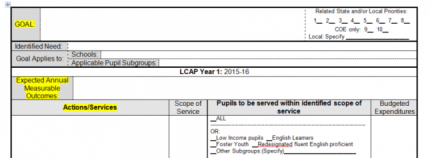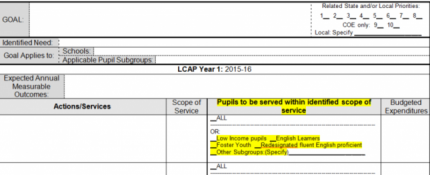By: Angelica Jongco
Date: April 27, 2015
We’re heading into the home stretch of the school year. That means that school districts (and charter schools) throughout the state are releasing drafts of their spending and academic plans, called Local Control Accountability Plans or LCAPs. Districts must develop these multi-year plans with community input under the landmark school finance law known as Local Control Funding Formula (LCFF).
While this lengthy LCAP document might make for suitable bedtime reading — with some thick enough to lay your head on — don’t be discouraged! You can conquer this plan day by day. Here is a list of 7 steps to guide you through the document. Take on one a day, and in a week, you’ll be the neighborhood expert on your school district’s LCAP. Use this new expertise to make sure your district budget responds to priority educational needs and reflects community engagement!
| VIEW OUR WEBINAR: To learn how to Monitor the Money, view the recording of our recent webinar: Ensuring Targeted Services Reach High Needs Students. |
Without further ado, here are 7 steps for sizing up your LCAP. Please click on each tip for more guidance!
- Assess whether the plan reflects
Meaningful Community Engagement. - Analyze the Annual Update for 2014-15.
Did the district follow through on its plans? - Review the Goals & Actions for 2015-16.
Do you agree with these goals and strategies? - Review what actions the district plans to take to improve outcomes for high-need students.
- Monitor the Money. Does the district clearly
describe spending required to implement actions?
- If the district is only including a sliver of its total LCFF dollars for 2014-15, ask why and press for greater transparency.
- Make sure the district is using funds generated by high-need students to improve the education for those students.
- Assess whether the plan reflects Meaningful Community Engagement?
- How will the district share out its draft plan and get feedback? Is outreach well publicized and designed to engage community?
- In Section 1 of the plan, does the district describe how it consulted with parents and caregivers, students and other stakeholders? How did community impact the plan?

-
Did the district use a Parent Advisory Committee and an English Learner Parent Advisory Committee (if it has more than 15% English Learners), which is required by law?
-
Did the district meet the minimum requirements to consult with students and what was the result?
-
Is the draft plan translated and did the district provide translation at engagement meetings?
-
Does the description of engagement match up with your experience?
-
Analyze the Annual Update for 2014-15. Did the district follow through on its plans?
Now skip ahead to Section 2, and flip past pages of goals and actions for the next three years. Stop at the Annual Update table. For each goal from last year’s LCAP, the school district must report on all the actions it had planned. Because this will likely be a long document, suitable for sleepy bedtime reading, start by focusing on the goals that are most important for you and community.

- Does the district explain in the “Actual Annual Measurable Outcomes” whether it made expected progress?

-
Review the left-hand side list of “Planned Actions/Services” and identify priority actions and services.
-
Now check, on the right-hand side, under “Actual Actions/Services,” did the district follow through? Did it spend the amount it had budgeted?
-
If this action was to take place at school sites, what was your experience with this strategy at your school?
-
If not, does the district explain why an action or service was not taken or funded?

-
Finally, in the bottom box, does the district explain what it plans to do differently? Do you agree or have advice based on your experiences with these actions and services?
- Review the Goals, Actions, Expenditures & Progress Indicators for 2015-16.Now flip back to the first part of Section 2 to review what the district plans to do over the next three years. We recommend focusing especially on Year 1: 2015-16.
- Do you agree with the goals that are listed? Are any missing? Identify the goals that are priority for you and your community and drill down deeper.
- Below each goal, the school district must identify expected annual outcomes. Do you agree with these outcomes? Are they ambitious enough? Do they focus on students with greatest needs?
- Then under “Actions/Services,” the district should list all actions and services it plans to take in support of that particular goal. Do you agree with these strategies? Are there any that you believe are missing or should be changed?

- Bonus question: When reviewing all of its goals, does the district address all required eight state priorities and metrics? (See the checklist on the upper right corner of each goal table.)
- Review what actions the district plans to take to improve outcomes for high-need students.You can tell what student populations are being served by looking at what options are checked in the box titled “Pupils to be served within identified scope of service.” What is the district planning to do specifically for:
- English Learners?
- Socieconomically impacted or low-income students?
- Foster Youth?
- Other vulnerable populations or subgroups?
- Are these in line with community expectations and is there sufficient funding?

- Monitor the Money. Does the district clearly describe spending required to implement actions?
- For each listed action, does the district describe “Budgeted Expenditures” in dollars?
- Does it explain what kind of funding is being used? For example, LCFF, Title I, Common Core Block Grant or a foundation grant?
- For LCFF funds, does the district explain when it is using “LCFF base,” which is available for all students, versus “LCFF Supplemental & Concentration” funds which must be used to increase/improves services for high-need students?

- If the district is only including a sliver of its total LCFF dollars for 2014-15, ask why and press for greater transparency.Are all the LCFF dollars the district receives included in the plan? Ask district staff for the total LCFF dollars in projected revenue for 2015-16. (This should match the amount contained in the district’s Adopted Budget for 2015-16 which must be reviewed/approved at the same meetings as the LCAP). Then ask how much LCFF spending is reflected in Year 1: 2015-16 of the LCAP. The LCAP is supposed to be a comprehensive plan that covers what a district is doing across its entire educational program. If the district is only including a sliver of its LCFF funding, ask why and press for greater transparency.
- Make sure the district is using funds generated by high-need students to improve the education for those students.School districts now receive dollars called “supplemental and concentration funds” that are specifically intended to improve outcomes for low-income, English learner and foster youth students (also referred to as high-need students). You can learn more about the proper use of these funds by viewing our recorded webinar on Monitoring the Money. Turn now to Section 3 of the LCAP.

- In Section 3.A, does the district list the total amount of Supplemental and Concentration funds? (It can be hard to figure out how the district reached this number. Feel free to contact Public Advocates for help.)
- Is there a clear description of how the district is spending Supplemental and Concentration funds this year? Do any of these uses sound funny to you? Examples of things to watch for: spending on special education services, spending on staff salary increases, spending on debt payments. Public Advocates has guides on some of these questionable practices.
- Where the district plans to spend these funds on services for the entire district or for an entire school, it has to give a good explanation. Does the district explain how the services are “principally directed” towards reaching its goals for high-need students? Does the district explain how the services will be effective?
- If the district has less than 55% high-need students (or a school has less than 40%), does the district describe how the services are the “most effective use” of funds to increase/improve services for those high-need students?

-
Now turn to Section 3.B. In the % box, does the district give a percentage for how much it must increase or improve services for high-need students as compared to all students? This is called the proportionality percentage and it lies at the very heart of LCFF’s equity promise to increase resources and improve outcomes for high-need students. Does the district provide the basis for its calculation? If not, ask the district to explain.
-
Does the district give a plausible explanation for how it is either adding new services or improving services for low-income students, foster youth and English learners by that percentage?

I hope you’ll use your newfound expertise to make your voice heard at an upcoming community forum. And please let me know how it is going.
For extra credit and to learn more about LCFF, visit Public Advocates’ LCFF webpage.



